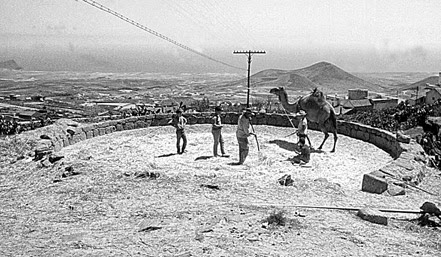WORTH KNOWING |
WALKING WITH THE LANZA (PALO CANARIO) |
On the hiking map, we have located most of the heritage highlights that can be seen along the hiking paths. They tell us about the difficult life that the inhabitants endured until recent times
AGRICULTURAL TERRACES
These terraces can be seen all around the island. At the end of the 19th century, many landless farmers had to leave the island, while others decided to stay and work on the steep and stony slopes. They built terraces far away from their villages and farmed cereals and potatoes. It is worth walking along the narrow paths to see these abandoned terraces.
Abandoned farm and water cistern
AGRICULTURAL TERRACES IN ISOLATED PLACES
THRESHING FLOORS
The culture of grains was the most important in the Canary Islands and Gofio (canarian flour made from roasted grains) the food staple. These round places were often built in high places or saddles to take advantage of soft and steady winds to facilitate the work of winnowing, separating the grain from the chaff, once the threshing was completed.
PATHS
Many paths were already built by the aboriginal people of the Canary Islands and widened by the castilian conquerors after the 15 th. century. There were different kinds of paths: Camino Real, the main path linking the villages, Traviesa (traverse paths), Camino de tira (used for the transportation of wood in oxcarts), Vereda (narrow path), Caminos de herradura (Chart tracks used by horses and donkeys), Camino de trillo (inside a private property), Atajo (shortcut), Camino vecinal (inside a municipality), Camino de prois o puertos (linking the village with its ports or docks and Pasada (just for shepherds in steep slopes)
Snow pit: Pozo de nieve de los Canónigos
Snow pit: Pozo de nieve Grande
SNOW PITS
Along the 18th, century, the use of ice became very popular among rich people who cooled their drinks and also was appreciated its therapeutic use against the fever. The snow was collected in custom made constructions known as snow pits. The first ones were built in Gran Canaria at the end of the 17th. century, in Tenerife around mid 18th. and later in that century in La Palma.
In Gran Canaria, when the mountains were covered with snow, 26 persons gathered it into baskets and 10 more arranged the snow in layers and trampled down hard to pack it into ice. On summer nights, blocks of ice were taken down on horses (80 kg) for 6 hours to the Cathedral of Las Palmas where it was sold.
CAVE- HOUSES
Often, while crossing gorges, carved caves can be seen at the bottom of sheer cliffs walls. Most of them were already carved by the aboriginal and used later by the european population. Some people are still living in the more luxurious ones, particularly in Artenara.
WATER CONDUITS, FILTRATION GALLERIES
The springs in the mountains, the wells in the flatlands and the collection of rainwater in some houses (many couldn't even afford this) ensured that enough water was available for the locals. However, some areas ran out of water in summer.
The old water conduits were carved by hand across steep slopes and sheer cliffs, and were very narrow. In the 20th. century, larger water conduits were built, wide enough to walk along them.
The filtration galleries are tunnels drilled and blasted through rocky mountains to tap into the water table. Some difficult hikes follow narrow paths that were built across steep slopes to reach the galleries.
Between 1510 and 1526, a channel (1400 m) was built from the source El Ancón to a 342 m long tunnel. At its northern exit, the water moved some watermills before it made its way to Las Palmas de Gran Canaria.
The first tunnel (60 x 30 cm) was built by aboriginal children. It was enlarged to a height of 2 m around 1970.
WATERMILLS
Watermills ground cereals for "gofio", the staple food of the Canary Islands. They used the water from sources and gorges, and many were built along the same valley. Conduits connected the mills and water flowed from one to the next.

